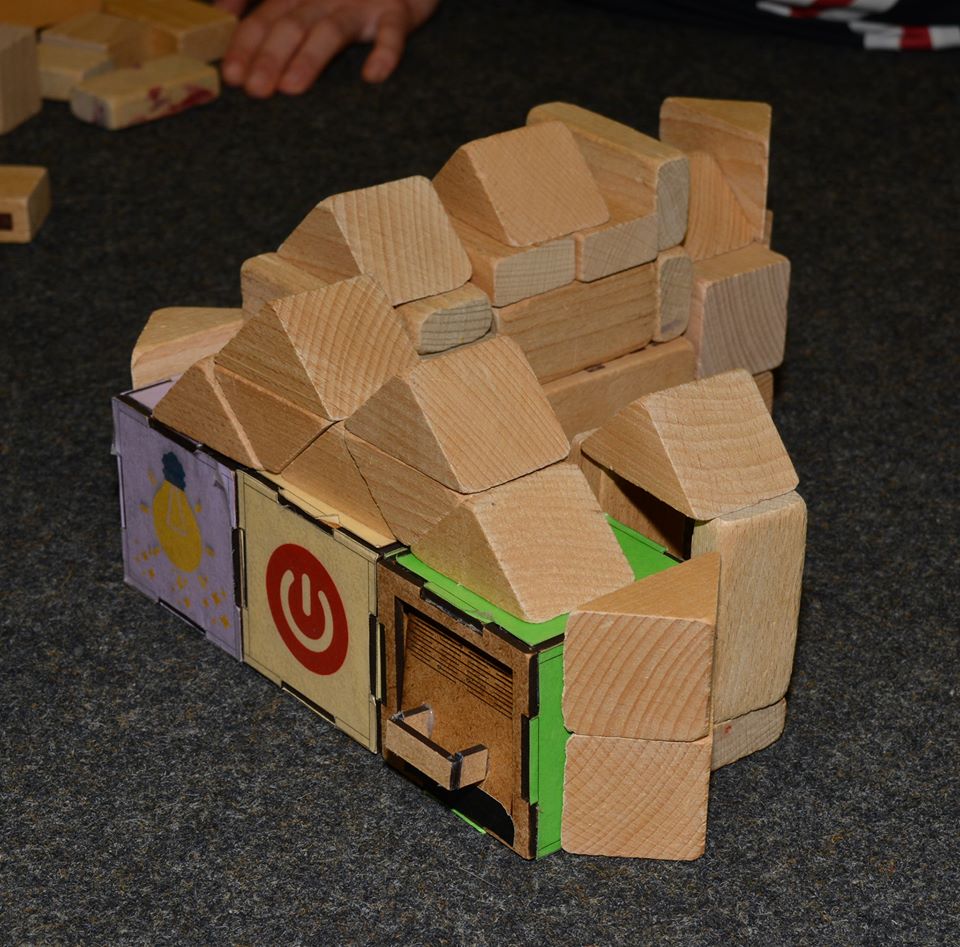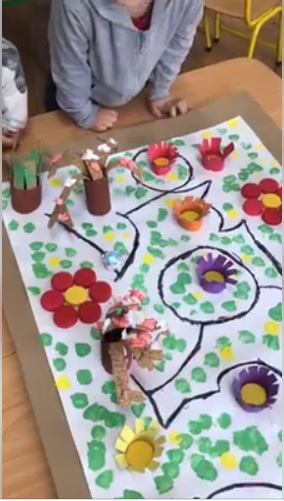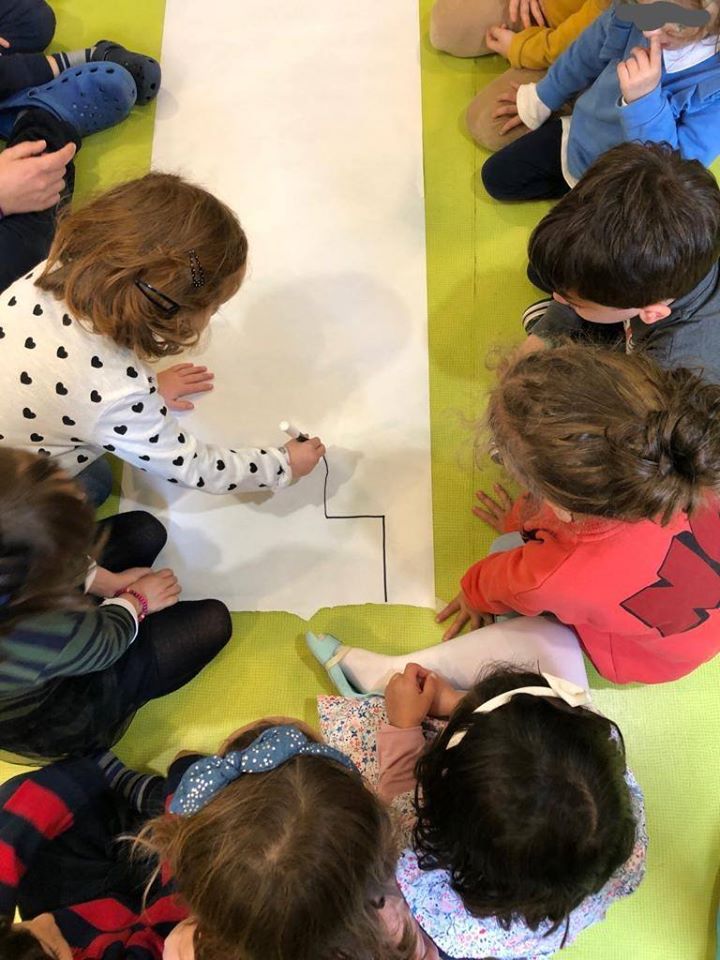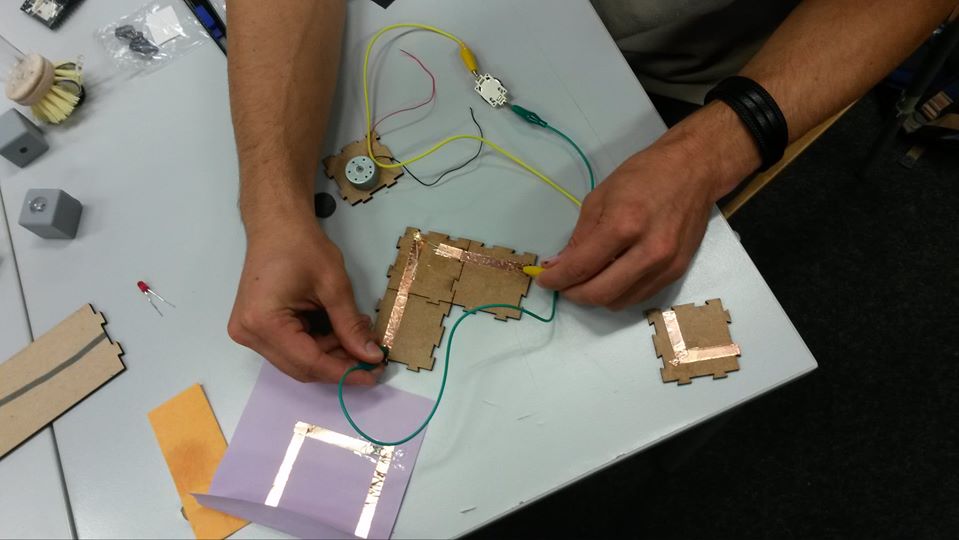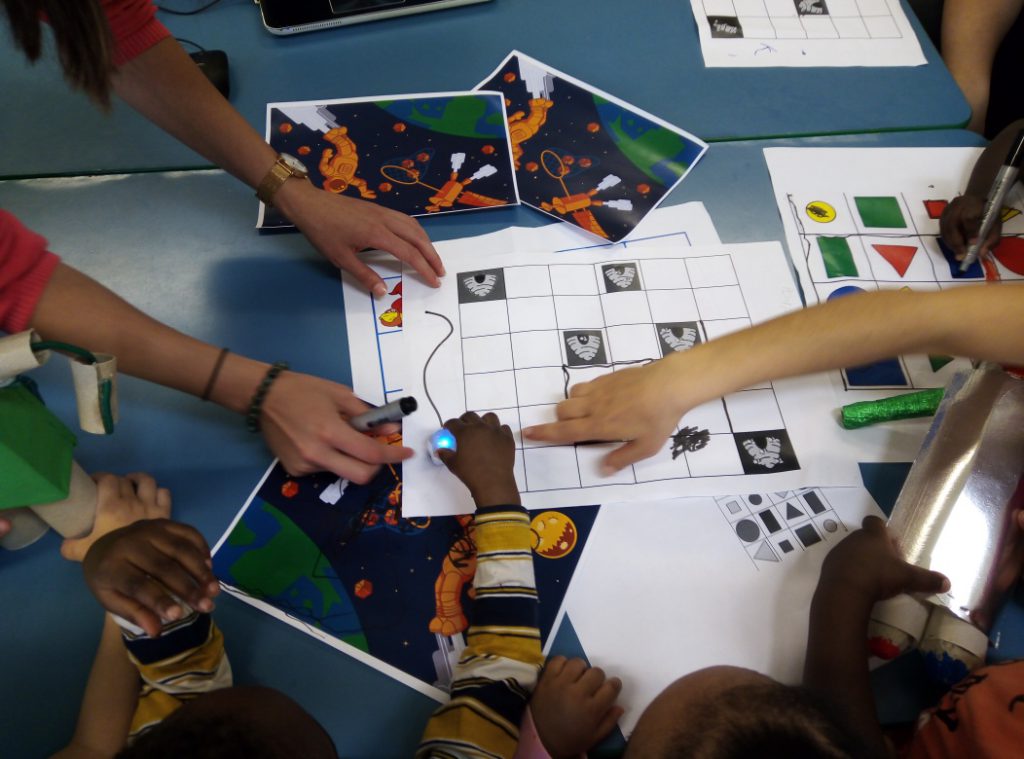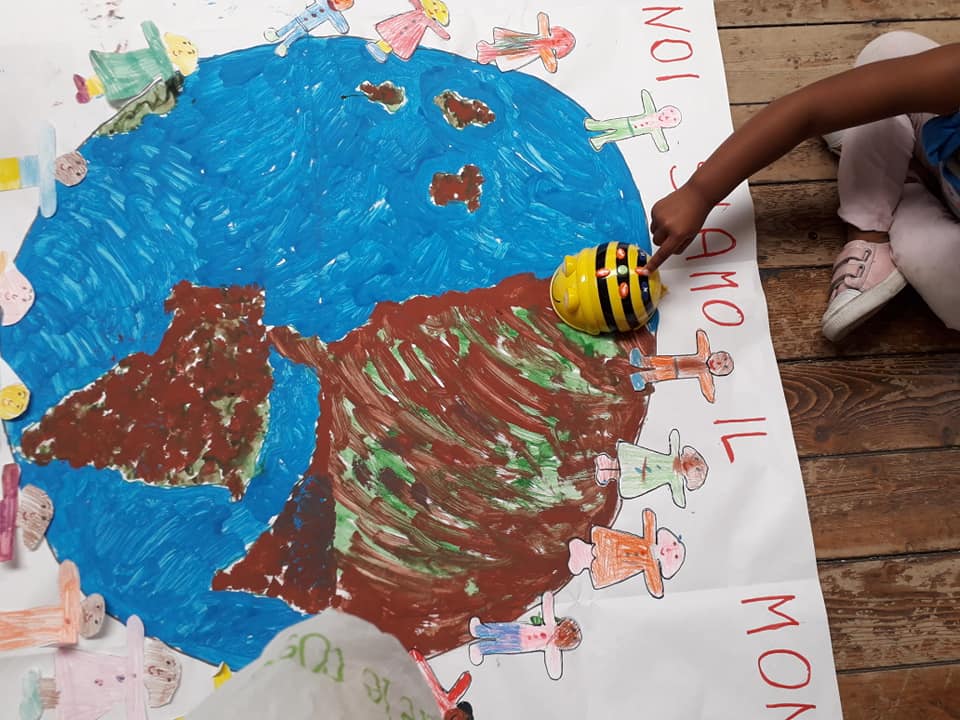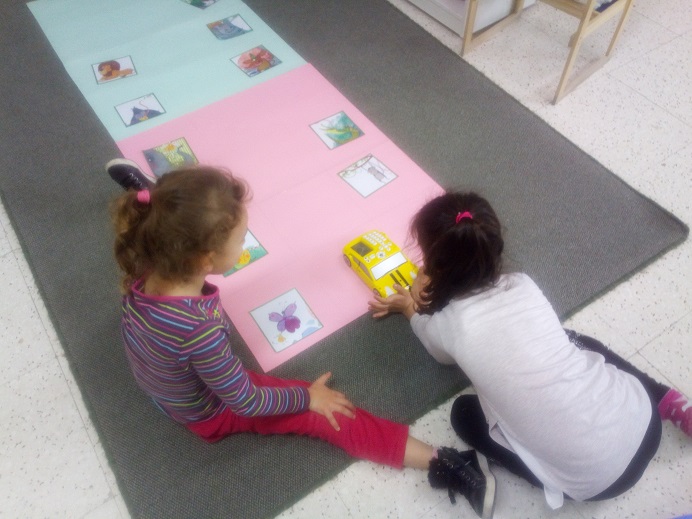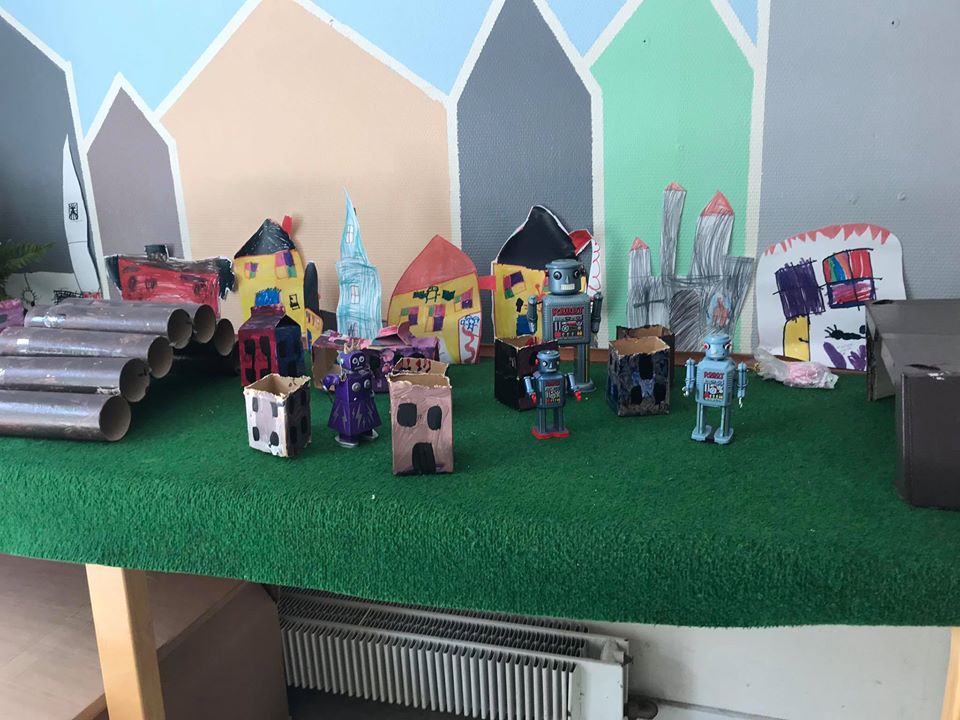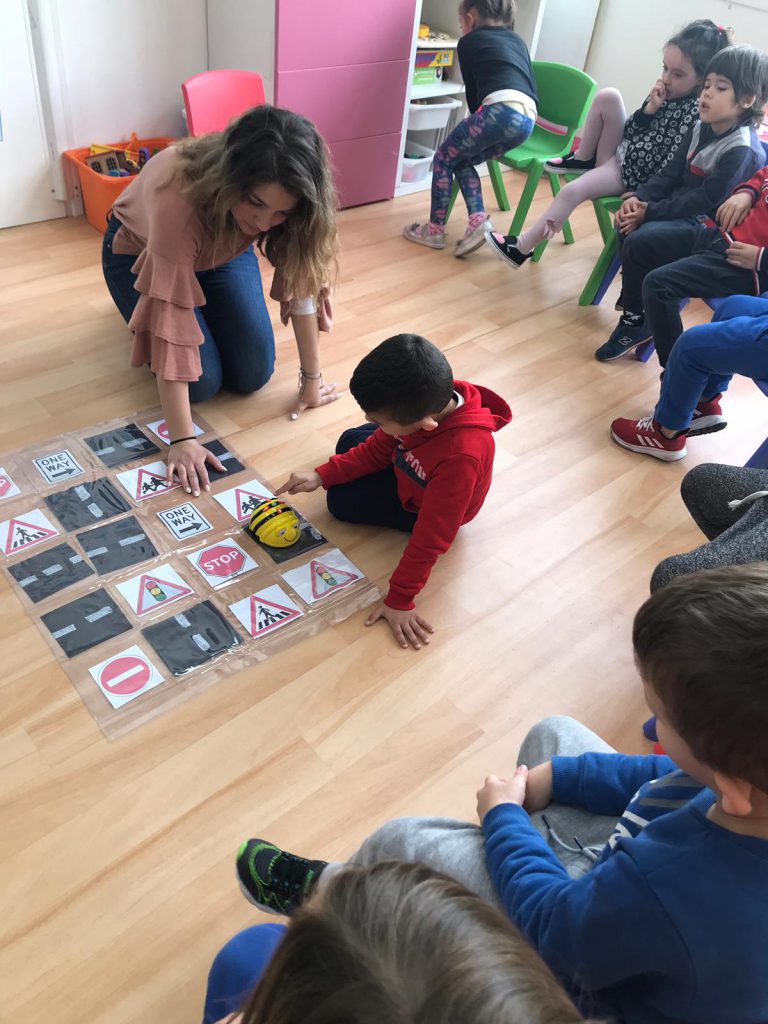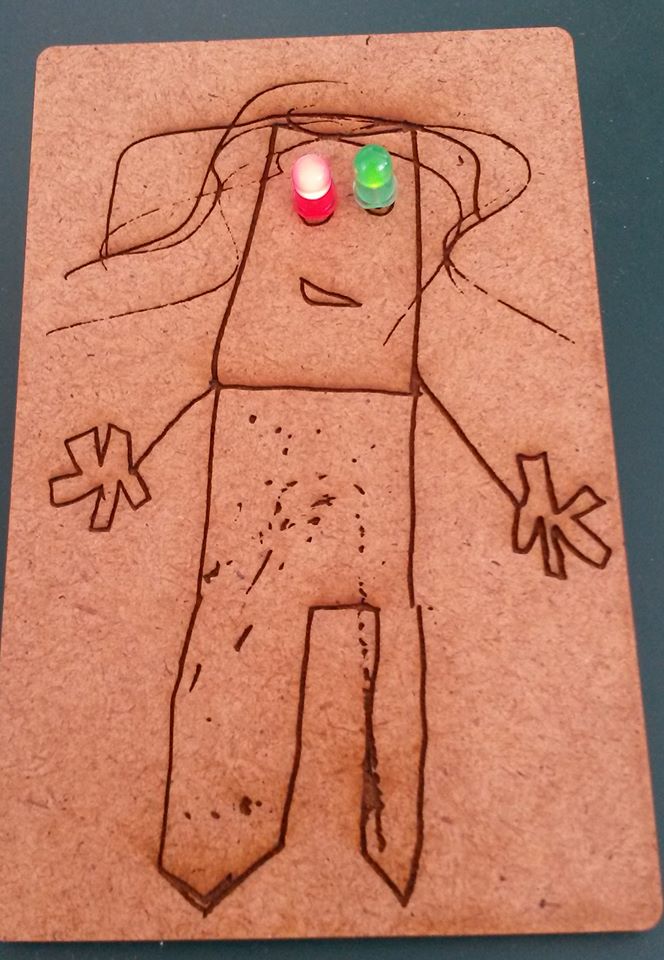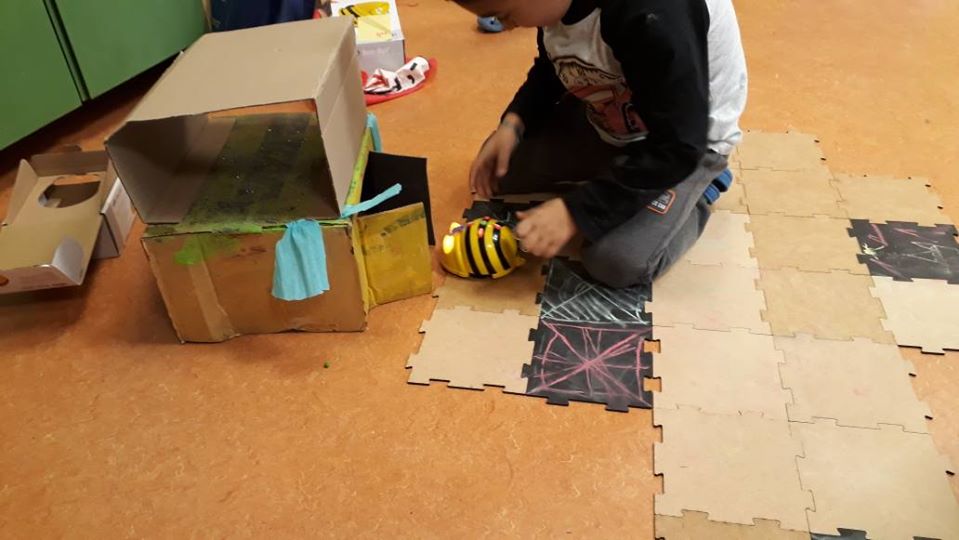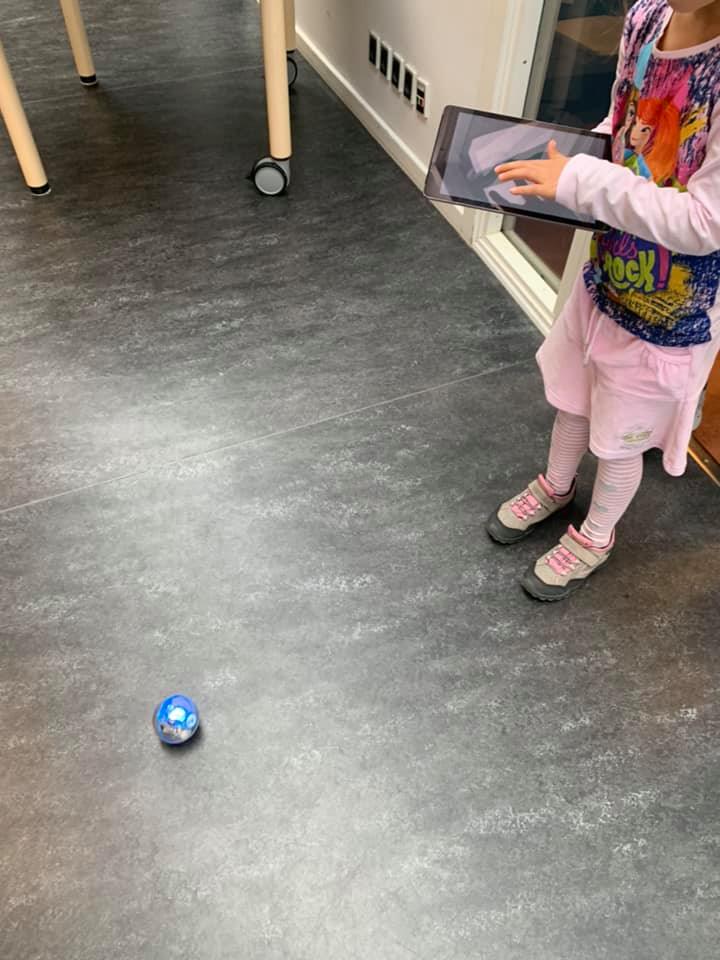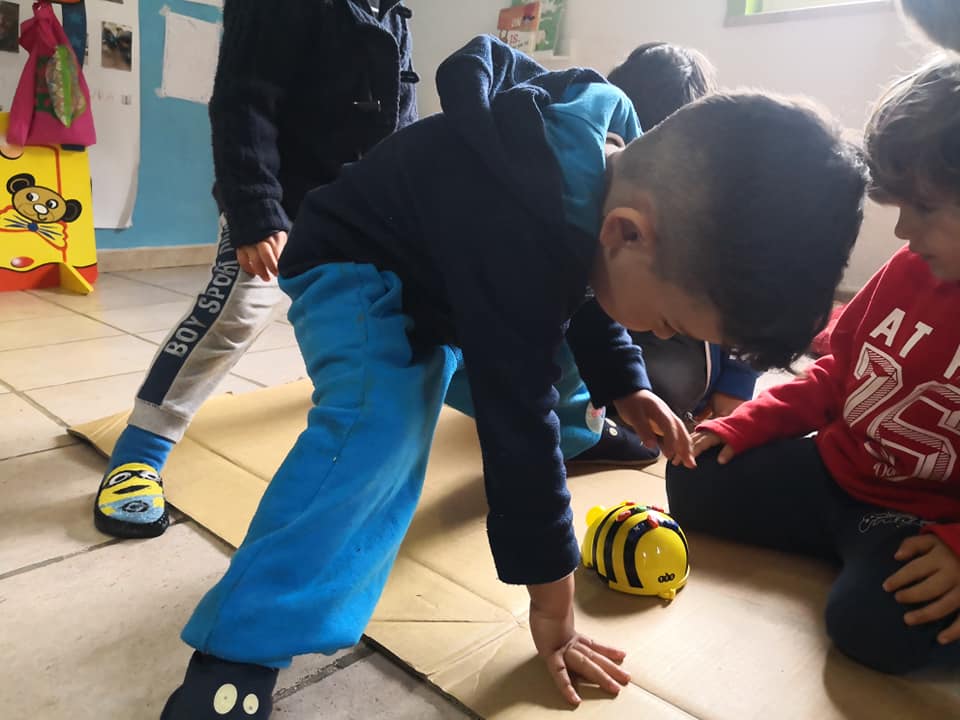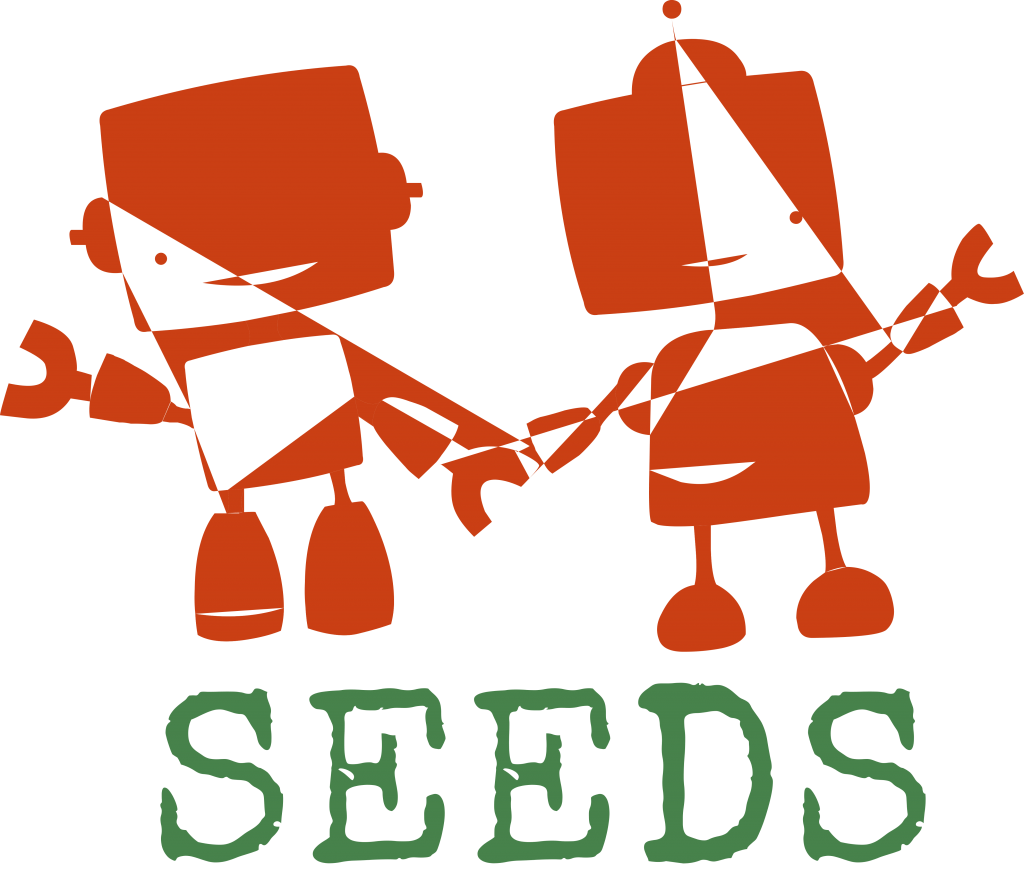


SEEDS Best Practice Example
On this page you will find 4 best practice examples from the project, which illustrate practical examples of the SEEDS Pedagogy with a step-by-step description and details on how to get started and what materials to use.
Moreover you will find other examples of activities that took place in the project and pictures from different activities in preschools in Germany, Cyprus, Italy and Denmark.
Learning about "The year in the garden" (Denmark)

The idea is to increase the childrens knowledge about vegetables and make them come alive with digital tools. The competences we want to work with is among others language and creativity. And also help the children to understand what we call “The year of the garden”.
As part of that we want to make QR-codes in the garden, where you can hear the children tell about the vegetables, while you look at a childs drawing of e.g. a carrot telling about carrots. Participating in the work were Preschool Children, Teachers, Janitor/helpers and parents – and can potentially involve gardeners and others with knowledge on nature, insects, etc.


Practicalities:
The concept is design for children between 5 and 6 years old and amount of children that can participate, depends on the amount of Teachers present.
The concept is done over potentially the entire garden season, but not with activities every day in the period.
Every activity can be done within two hours, but also stretched over longer time (Which is recommended).
The materials used are among others:
The garden: Seeds, paper, crayons
Technology: Mobile phone, Ipad (Camera and apps like My Talking Pet, Chatter Pix, PC, QR-codes
The Starting Point:
An open discussion with the children about which Vegetables you want in the garden. The follow up with activities like visiting the garden, make drawings, introduce the technology you want to use, etc.
Pedagogical Methods and Principles:
The project is in one way very organized. On the other hand not. We have a plan, but we are constantly looking for a way to change it or ready to change it, if new and better ideas appears. An example is the Insect Hotel, that was not part of the original plan, but seem like a brilliant idea and was therefor included.
The pedagogical method is a mixture of the following:
Co-Collaboration: We develop together and each child can tell their own story within the concept.
Experimenting: We have not tried the mix between technology and vegetables, su this Is very new for us. The use of technology in general is also new.
Mixing real life and digital life: This project mixes both analog and digital, but in a way where the analog story is the main focus.
The Competences supported in this project are the following:
Creativity: Through involving the production of drawings, videos and storytelling
Collaboration: Through making plans for the garden together
Language skills: Through Telling the stories them selves (On behalf of the Plants)
Knowledge about the topic of nature: Through introduction to gardening, insects and animals.
Step by Step:


The concept is build around a set of activities following the year of the garden. The Activities can variate depending on what garden you have, the knowledge and access and to technology, what sort of extra activities you can do, etc.
1. Introduction to topic of the garden:
– A talk about gardens, what vegetables the children like, what insects and animals they know live in a garden, etc.
2. Concrete planning of which vegetables you want in the garden:
– Agreeing on what vegetables you want to plant
– Introduktion to the chosen vegetables
– A walk in the garden to find out where to plant them.
3. Working with the knowledge about the plants:
– Making Drawings of the vegetables.
– Giving the vegetables eyes and mouth
– Introduction to iPad apps, such as My Talking pet, Chatter Pics and Puppet Pals. These apps will be used to make videos about the vegetables.
– Introduction to QR codes and how you use them for introductions to the plants.
4. Making the vegetables come alive:
– Use the drawings with the apps and videoes where the vegetables tell about them selves.
(Link to a video)
5. Planting the seeds:
– Go into the garden and plant the seeds.
6. Connecting the vegetables videos with the vegetables in the garden:
– Create QR codes for the videos
– Print out the QR codes
– Set the printed QR-codes into the garden



Follow up ideas could be:
– “Play” with Sprouts and look at how the grow – roots, how fast the grow, look at the differences
– Taste and smell to the flowers and vegetables make e.g. jam and juice
– Build an insect hotel
In a way the ideas can be organized in the same way as an explorative activity, but can also be a logic extra level in the concept of “The year of the garden”.


Copying Intention
The first phase of the SEEDS pedagogy begins with perhaps a very traditional way of thinking about teaching and learning. One does not need to start here but for many teachers this is a traditional way of thinking about learning. The question is closed. The teacher is the one who decides what is to be learned and how it is to be learned. The teacher is the expert and takes responsibility for deciding how the learners will approach the learning and what the intended result of their learning will be beforehand. This is why this phase is called copying intention. One Danish institution has worked with the outside environment and the growing of an edible garden. The challenge was to link this work with digital technology in a meaningful way. Working in a garden means understanding the seasons – that there is a time for everything and each period of time has different requirements. There are plants to be sown, soil to be tended, conditions need to be right (heat and water) and there needs to be an awareness of what bio-diversity is needed for optimal growth e.g. bees, insects, soil conditions etc. While there is a lot of knowledge online about all of this the teachers wanted to the children to take a different approach by being producers not only of vegetables but of information about what the vegetable needs for the best growth possible. The children had experience of tending a garden, sowing and cultivating plants. The children were asked to make a drawing of the vegetable they were growing. The teacher introduced apps (my talking pet?) that allowed the children animate their drawings. The vegetable was given a voice (the child’s) and could now talk about how it could be eaten, or what kind of growing conditions it needed depending on what information the child thought was important. This meant formulating a story for others.
Discovering Potential
The next phase may also be recognizable to many teachers. The intention is to allow for new experiences and to embed learning. Next the teacher introduced the QR code that allows someone to scan and get the information. The experience of walking through the garden is changed as others can see and hear the information that the children think important. The children were the main actors in this process being responsible for the drawing, the animation and the text and voice over.
Seeking Transformation
In the next phase, the teacher may ask questions that she does not have the answer to – or use questions that come from the children, to which she again does not have the answer. The children then began asking other questions about the garden. This meant that the teacher found out that other adults could be important for the children to learn about plants that included bringing for example the janitor, parents, and other adults who have an interest or expertise in bio-diversity. For example, the importance of insects suddenly became interesting for the children. One child had seen an insect hotel that started another outdoor project. The children became involved in this work and made pictures of different insects, animated these drawing and made short information videos about what the insects were doing in the garden and why they needed refuge in the hotel. The work in the garden is not only about the environment. Conversations about what to plant also involved what children like to eat, and what they have not eaten. The conversations extended to how we can prepare different foods and how versatile a vegetable might be. The children became involved in making jams and juices.
Establishing a common value
In the phase following this the process becomes much more open. The group discuss what they would like to do. One child suggested that the QR codes could be used to help newcomers find their way around the school. They made drawings of different areas and the rules that applied for the area. The group will decide quite quickly what is important and meaningful for them. Here we note the motivation of the children and the concentration and engagement they exhibit when they have ownership of their learning process. The teacher’s role is, not only to support learning, but also to make sure that there is critical reflection and their competencies become visible. The process does not end here. As the group finds out what is important to them, what is meaningful and of value they will find the path they want to take. This journey is dependent on the group of learners and the ecology they find themselves in.
Programming Botley and Beebot for pentomino solutions (Cyprus)

This activity was prepared by B’ Palaiometocho Public Kindergarten in Nicosia, Cyprus.
Introduction:
The activity was designed to help children understand how to give directions for space by transferring what they learned in math through programming (beebot and botley). They used raw material such as pentomino puzzles, markers and pencils and technologies such as beebots and botley.
The objectives of the activity:
- Strengthen collaboration and communication by encouraging children to talk to each other and exchange ideas on how to the robots (botley and beebot) will get to the box and at a later stage to the 5 boxes of the pentomino puzzles.
- Increase their capacity to perceive space by helping children understand concepts such as left, right, front, and back.
- Learn how to critically-think and assess whether a solution works or not. Children explored different solutions by testing them.
- Enhance verbal and written communication. Children explained what they think by taking into account each other’s ideas and thoughts.
- Strengthen problem-solving skills by trying to figure out how to solve a problem.
- Learn how to record solutions by using botley cards or making their solutions by pointing the route they are planning to follow.
- Strengthen critical-thinking skills and children feel empowered.
Strengthen patience and perseverance by exploring different solutions and testing out different ideas.
Praticalities:
Children’s average age: 4-6 years old
Number of teachers: 1
Number of children: 35
Duration of the activity: 20’x3
Materials:
Circuits, nylon, markers, pentomino solutions/puzzles, paper boards, Botley cards, paper, pencils, beebot, botley
Starting Point:
Children had the opportunity to play and experiment with the botley and the beebot and learn how they work.
Pedagogical Methods and Principles:
By exploring how each robot moves, children enhanced their communication skills. They learned how to collaborate with each other to measure and create squared on the board.
Children used critical-thinking skills through by solving the pentomino puzzles and having the robots moving across the squares. They learned how to take into account each other’s ideas while they were experimenting with the robots.
They learned how to observe and record similarities and differences.
Step by step:
Step 1: Children measured botley steps in order to create squares on the board.
Step 2: Children recorded different routes in order to get to the robot.
Step 3: Then after playing with the beebot, they compared it with the botley (recorded similarities and differences)
Step 4: Then, they measured the steps of the beebot and created squares for it to move.
Step 5: Then they played with the beebot and the botley and added pentomino solutions to guide them through the squares.
Step 6: Children created their own robots and named one the Palaiometocho Bot (name of the school and the town).
Step 7: Then, they used the robots to travel to the SEEDS countries.
Other suggestions:
Using different robots to explore how each robot moves and how they react to obstacles.
Using applications on tablet to create story characters using the botley and the beebot.
Copying Intention
The first phase of the SEEDS pedagogy begins with perhaps a very traditional way of thinking about teaching and learning. One does not need to start here but for many teachers this is a traditional way of thinking about learning. The question is closed. The teacher is the one who decides what is to be learned and how it is to be learned. The teacher is the expert and takes responsibility for deciding how the learners will approach the learning and what the intended result of their learning will be beforehand. This is why this phase is called copying intention. In a Cypriot institution, the teacher wanted to combine maths and working with the Beebot. The children were aged 4-6 years. The children worked together sharing a Beebot between them. The teacher began by introducing them to the Beebot and let them find out what the buttons were for. Once the children had experience of this the teacher asked them to make the Beebot move from one position to another. The Beebots were lined up and the children had to work out how many times they should press the forward button to reach the destination. The teacher asked the children how they knew how many times to press the button. There was a discussion about guessing and being right or wrong.
Discovering Potential
The next phase may also be recognizable to many teachers. The intention is to allow for new experiences and to embed learning. The teacher then asked the children to find out how far the Beebot could travel when the button was pushed once. She provided different material in the form of building blocks that could be fitted together. The children found out that they could ‘measure’ the step of the Beebot. They measured the step by putting blocks together to correspond with the distance travelled. For example, one group found that nine blocks corresponded to one Beebot step. When they had discussed the different materials and which was ‘best’ for measuring, the teacher gave the children a large mat that was divided up into squares where each square represented one Beebot step. The children could then plan the route that the Beebot could take across the mat. The teacher introduced pictures that could be inserted into a square on the mat. The children chose the pictures they wanted for their mat. Now one child could tell another that the Beebot should travel to the horse.
Seeking Transformation
In the next phase, the teacher may ask questions that she does not have the answer to – or use questions that come from the children, to which she again does not have the answer. The children had some experience with a Botley and wanted to know if it could move over the mat in the same way as the Beebot. Some children were more interested in making up stories about the Beebot and the pictures. Others wanted to put their own drawings on the mat.
Establishing a common value
In the following phase, the process becomes much more open. The group discuss what they would like to do. Again, the children had experience of using pentomino puzzles and were curious about solving them with both the Botley and the Beebot. Through these activities the children familiarised themselves with the robots, learned about difference and about measuring and recording for comparison.
Bremen (Germany)

The idea is to increase the childrens knowledge about vegetables and make them come alive with digital tools.
The competences we want to work with is among others language and creativity. And also help the children to understand what we call “The year of the garden”.
As part of that we want to make QR-codes in the garden, where you can hear the children tell about the vegetables, while you look at a childs drawing of e.g. a carrot telling about carrots.
Participating in the work were Preschool Children, Teachers, Janitor/helpers and parents – and can potentially involve gardeners and others with knowledge on nature, insects, etc.
Practicalities:
The concept is design for children between 5 and 6 years old and amount of children that can participate, depends on the amount of Teachers present.
The concept is done over potentially the entire garden season, but not with activities every day in the period.
Every activity can be done within two hours, but also stretched over longer time (Which is recommended)
The materials used are among others:
The garden: Seeds, paper, crayons
Technology: Mobile phone, Ipad (Camera and apps like My Talking Pet, Chatter Pix, PC, QR-codes
The Starting Point:
An open discussion with the children about which Vegetables you want in the garden. The follow up with activities like visiting the garden, make drawings, introduce the technology you want to use, etc
Pedagogical Methods and Principles:
The project is in one way very organized. On the other hand not. We have a plan, but we are constantly looking for a way to change it or ready to change it, if new and better ideas appears. An example is the Insect Hotel, that was not part of the original plan, but seem like a brilliant idea and was therefor included.
The pedagogical method is a mixture of the following:
Co-Collaboration: We develop together and each child can tell their own story within the concept.
Experimenting: We have not tried the mix between technology and vegetables, su this Is very new for us. The use of technology in general is also new.
Mixing real life and digital life: This project mixes both analog and digital, but in a way where the analog story is the main focus.
The Competences supported in this project are the following:
Creativity: Through involving the production of drawings, videos and storytelling
Collaboration: Through making plans for the garden together
Language skills: Through Telling the stories them selves (On behalf of the Plants)
Knowledge about the topic of nature: Through introduction to gardening, insects and animals.
Step by Step:
The concept is build around a set of activities following the year of the garden. The Activities can variate depending on what garden you have, the knowledge and access and to technology, what sort of extra activities you can do, etc.
1. Introduction to topic of the garden:
– A talk about gardens, what vegetables the children like, what insects and animals they know live in a garden, etc.
2. Concrete planning of which vegetables you want in the garden:
– Agreeing on what vegetables you want to plant
– Introduktion to the chosen vegetables
– A walk in the garden to find out where to plant them
3. Working with the knowledge about the plants:
– Making Drawings of the vegetables.
– Giving the vegetables eyes and mouth
– Introduction to iPad apps, such as My Talking pet, Chatter Pics and Puppet Pals. These apps will be used to make videos about the vegetables.
– Introduction to QR codes and how you use them for introductions to the plants.
4. Making the vegetables come alive:
(Link to a video)
– Use the drawings with the apps and videoes where the vegetables tell about them selves.
5. Planting the seeds:
– Go into the garden and plant the seeds
6. Connecting the vegetables videos with the vegetables in the garden:
– Create QR codes for the videos
– Print out the QR codes
– Set the printed QR-codes into the garden
Follow up ideas could be:
– “Play” with Sprouts and look at how the grow – roots, how fast the grow, look at the differences
– Taste and smell to the flowers and vegetables make e.g. jam and juice
– Build an insect hotel
In a way the ideas can be organized in the same way as an explorative activity, but can also be a logic extra level in the concept of “The year of the garden”.
Copying Intention
The first phase of the SEEDS pedagogy begins with perhaps a very traditional way of thinking about teaching and learning. One does not need to start here but for many teachers this is a traditional way of thinking about learning. The question is closed. The teacher is the one who decides what is to be learned and how it is to be learned. The teacher is the expert and takes responsibility for deciding how the learners will approach the learning and what the intended result of their learning will be beforehand. This is why this phase is called copying intention. The teacher has a limited number of Beebots. She asks the children to work in pairs with one Beebot between them. She begins by explaining that the buttons tell the Beebot where it should move. The teacher asks one child from the group to make the Beebot move across the floor to another child. The child presses the buttons. The child finds out which button makes the Beebot move forward. The teacher asks if they can make the Beebot turn. The children find out that the buttons have to be pressed in sequence and maybe multiple numbers of times. The teacher then made up some activities with different goals to allow the children to try out the buttons and find out what they need to do to make the Beebot reach the destination. The word programming may also be introduced. The children find out that ‘programming’ is not difficult.
Discovering Potential
The next phase may also be recognizable to many teachers. The intention is to allow for new experiences and to embed learning. In this example, the teacher introduces ready-made tiles that correspond to the distance when the button is pressed once. (These were made in a Fablab for the school). The teacher shows the children how she can get the Beebot to move across the tiles following the route she has made. She has drawn a beehive on one tile (home) and a flower on another. She questions the children on how to get the Beebot to move from home to the flower. They try this together and then she gives tiles to each group of children. They lay them out and program the Beebot to move from home to their flower. This may involve calculating turning and moving forward multiple times. The introduction of tiles, or another material, can help challenge skills and develop the critical thinking of the child. Here the teacher becomes a facilitator, allowing the children to design their own formation of the tiles. The outside world, relating to real bees, for example, may be drawn in by talking about the bee flying to a flower to collect nectar. Drawing a flower on the tile and a honeycomb on another will be part of the exercise. In this phase, the children will naturally look at what others (groups) are doing and will get ideas or copy them. The notion of copying in this scenario is encouraged as copying means that there will be, by default, some kind of transformation and difference.
Seeking Transformation
In the next phase, the teacher may ask questions that she does not have the answer to – or use questions that come from the children, to which she again does not have the answer. In this example the children asked what the object on the back of the Beebot was for. When they were told that it could be used to hold a pen the children asked for paper. In this phase, it is the children who came up with ideas and asked questions. The teacher, moving from facilitator to participator became part of the group and the results of the activity changed it and transformed the learning to include other knowledge. Here the openness to the outside world and to narratives may be of significant importance.
Establishing a common value
In the phase following this the process becomes much more open. The group discuss what they would like to do. One child wanted the beebot to fly, another wanted to put it with an ozobot and see if they could become friends. The group will decide quite quickly what is important and meaningful for them. Here we note the motivation of the children and the concentration and engagement they exhibit when they have ownership of their learning process. The teacher’s role is, not only to support learning, but also to make sure that there is critical reflection and their competencies become visible. The process does not end here. As the group finds out what is important to them, what is meaningful and of value they will find the path they want to take. This journey is dependent on the group of learners and the ecology they find themselves in.
Discover our Bodies (Italy)

In pre-schools, it is fundamental for educators to always think on new and stimulating ways of discovery. This activity has been developed by the educators of La Piccola Casa nel Bosco, a pre-school in Palermo (Italy).
The activity was designed to let children discover their body and corporeality, in order to promote self-knowledge, through movement, expressiveness and sensory stimulation.
Main Objectives:
- Promote individual growth through collaboration and play;
- Build a positive self-image;
- Implement educational strategies with the use of new technologies;
- Know and use appropriate technologies for pre-schoolers (ozobot).
Practicalities
Children’s average age: 5 years old
Number of teachers: 2
Number of children: 6
Materials: ozobot, cardboard, markers
Duration of the activity: 2 hours
Starting Point
Teacher introduces the game-activity to children though guided conversation, and explains how to use the ozobot, a little toy robot that recognize lines and follow them.
Pedagogical Methods and Principles:
The Ozobot became a self-awareness tool. It could be used as mean for children to learn a foreign language.
Step by step
Step 1: Children lay down on the cardboard one at a time.
Step 2: Children draw the silhouette of the lying companions.
Step 3: Children become aware of the parts of their body through the ozobot that follows their silhouette.
Other suggestions:
Suggestion 1: Each child could divide the parts of their drawings following the teacher’s instructions (i.e head, arms, hands, torso, feet) and let the ozobot explore them.
Suggestion 2: To enhance the awareness on their bodies, children can touch the parts of their bodies when the ozobot pass on it.
Suggestion 3: Children could say aloud the parts of the body when the ozobot pass on them, and also translate them in English to learn a learning a foreign language.
Copying Intention
The first phase of the SEEDS pedagogy begins with perhaps a very traditional way of thinking about teaching and learning. One does not need to start here but for many teachers this is a traditional way of thinking about learning. The question is closed. The teacher is the one who decides what is to be learned and how it is to be learned. The teacher is the expert and takes responsibility for deciding how the learners will approach the learning and what the intended result of their learning will be beforehand. This is why this phase is called copying intention. In a Sicilian institution, the teacher wanted to introduce children aged 2-3 years to Ozobots. The teacher shows the children the Ozobot that can follow a line. The children are given pens so that they can draw a line. The Ozobot is place on their line and they watch to see if it can ‘see’ the line. The teacher helps the children who have difficulty making a line the Ozobot can ‘see’. The line did not have to be a straight line so the children could make their own paths for the Ozobot to follow. The children make a drawing of, for example a house or an animal, and a path. The Ozobot is placed on the path and they find out if it can get to the house or animal.
Discovering Potential
The next phase may also be recognizable to many teachers. The intention is to allow for new experiences and to embed learning. In the next activity, the children draw a line around their hand and then find out if the Ozobot can follow it. Then the teacher suggests that they could get the robot to move around their whole body if someone could draw it on the floor. One child lies down on a large piece of card and the teacher draws a line around their body. The children were excited to see that the Ozobot could follow the line around the body which introduced body parts and maybe new language into the conversation. The silhouettes were made for a number of children who also painted their drawings so that the different body parts had different colours. The teacher shows them that if they put different colours into the line they can make the Ozobot stop at certain points around the body. The children were happy to experiment using the Ozobot and the life-sized drawings they had made of themselves.
Seeking Transformation
In the next phase, the teacher may ask questions that she does not have the answer to – or use questions that come from the children, to which she again does not have the answer. In later activities, the teacher planned to introduce the idea of organs of the body and talk about where they were situated and what they did. The teacher found that the activity encouraged language development and an interest in the body and its functions.
Establishing a common value
In the phase following this the process becomes much more open. The group discuss what they would like to do. As this is a very young group of children the teacher made suggestions to find out what the children were interested in. In a later activity, the teacher planned to introduce LED lights to the children’s drawings as they were fascinated by the different lights on the Ozobot. The teacher’s role is, not only to support learning, but also to make sure that there is critical reflection and their competencies become visible. The process does not end here. As the group finds out what is important to them, what is meaningful and of value they will find the path they want to take. This journey is dependent on the group of learners and the ecology they find themselves in.
Pictures from the project activities in preschools
